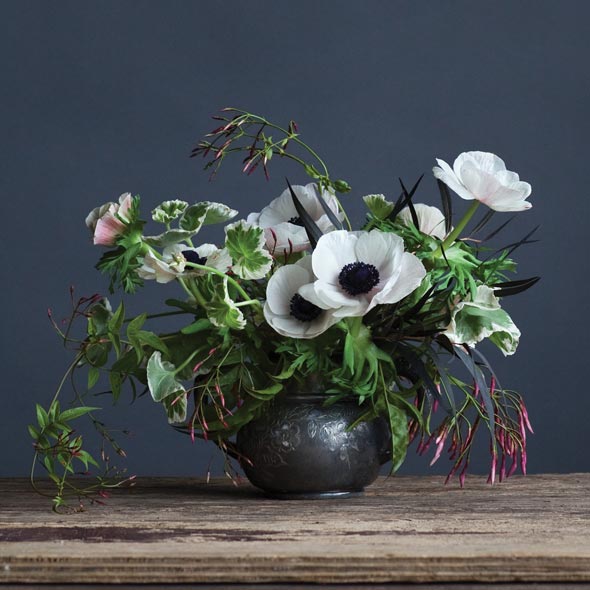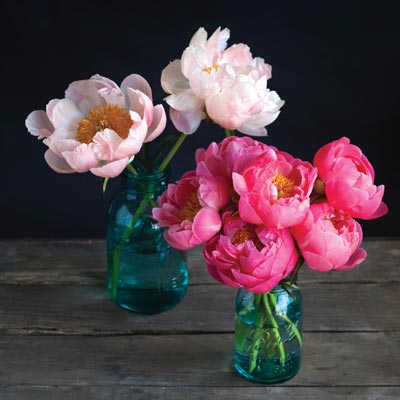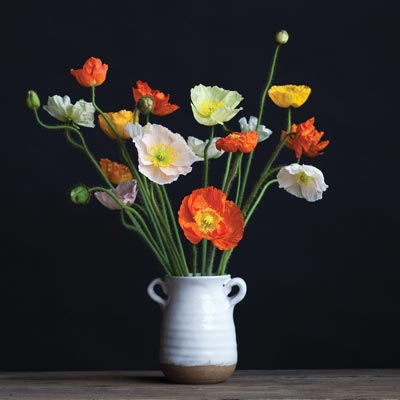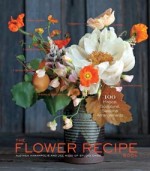Easy Flower Arranging
On Mother’s Day (May 10) impress your mom — and yourself! — by crafting a simple yet sophisticated seasonal arrangement from The Flower Recipe Book (Artisan Books) by Alethea Harampolis and Jill Rizzo of Studio Choo Florists.

Anemone
Photo by Paige Green
Anemones sport cute black (and sometimes green) button centers and frilly petal collars. They can be challenging to use in arrangements when they have really bendy stems, but the right display accentuates their curves.
Anemone with Company
Flowers
- 3 stems of geranium
- 4 stems of agonis
- 7 stems of anemone
- 3 vines of jasmine
Vessel
- Vintage sugar bowl
Directions
- Trim and place stems of geranium and agonis in bowl so that lowest leaves rest at its rim.
- Trim and add five stems of anemone to rest on geranium leaves in center of bowl, and remaining two stems so that they’re a few inches higher on the left and right.
- Trim and tuck jasmine vines so that two drape over edges of bowl and one reaches out to top of arrangement.
- Add only a few inches of water. Anemone stems are hollow and will rot quickly in deep water.

Peony
Photo by Paige Green
The Coral Charm variety undergoes an amazing transformation, opening from a tight ball to a giant, hot-pink flower that fades to antique cream just before its petals drop. Select buds that are just open enough to show their colors so that you can enjoy them as long as possible.
Peony Recipe
Flowers
- 9 peonies (the same variety at different stages of openness)
Vessels
- 2 blue mason jars
Directions
- Trim and add three stems to the first jar so that the blooms rest 2 inches above the rim.
- Trim and add four stems to the same jar so that the bottoms of the blooms sit just above the first three flowers, creating a tight mass of blooms.
- Trim and add the last two stems to the second jar so that the blooms sit at slightly different heights, a few inches above the rim.

Poppy
Photo by Paige Green
With tissue paper petals and skinny, tendril-like stems, poppies are so ethereal, they seem to practically float on air. Their tight, furry, unopened buds are a striking combination next to the colorful explosion of an open bloom.
Poppy Recipe
Flowers
- 20 poppies
Vessel
- Handmade ceramic vase
Directions
- Attach a flower frog to the bottom of the vase with floral putty.
- Trim and burn the stems* and add the poppies to the base at varying heights so that each stem has its own space within the arrangement, and no blooms are touching.
*Stem Burning. We’ve found that burning the stems of poppies allows them to open and stay intact for quite a while. The technique is simple: Just hold the newly cut end of a poppy’s stem in the flame of a lighter for a few seconds.

Excerpted from The Flower Recipe Book by Alethea Harampolis and Jill Rizzo (Artisan Books). Copyright © 2013.
Cut Flower Care
Brightening your home with beautiful bouquets is one of the perks of flower gardening, and there are techniques for cutting and preserving flowers so they stay fresh and beautiful for as long as possible. But these techniques can vary from flower to flower, depending on the type of plant. Roses, for example, like other flowers, are best cut in early morning or evening or on cool, cloudy days to minimize moisture loss. Remove leaves that will be below the water line. Cut the stems off diagonally to enlarge the absorption surface, and do this while the stems are immersed in water so they won’t be obstructed by air bubbles. Treat asters and snapdragons in the same manner.
Cut roses, daffodils, gladiolas, and irises when the flowers are in bud. They will open in the vase. Other flowers such as marigolds, delphiniums, and dianthus should be cut after opening. After cutting the stems with a sharp, nonserrated knife, immerse the stems in a pail of lukewarm (never cold) water and place in a cool spot out of the sunlight for a few hours. This will increase longevity.
Flowers with hollow stems, such as daffodils, delphiniums, and amaryllis, will live longer if you turn them over after cutting, fill the stems with water, then place a plug of cotton in the base and submerge the stems immediately in the vase.
Before putting daffodils, hollyhocks, hydrangeas, or poppies in a vase, singe the ends briefly with a lighted match. This will keep the milky substance in their stems from coagulating and blocking their water supply. It will also prevent the milky substance from entering the water and adversely affecting other flowers.
To prepare clematis flowers, pour boiling water on the stems and then place them in cold water. Additionally, like some people, these flowers prefer a little nip to stay happy. The Japanese dip them in an alcoholic beverage, such as champagne, for a few hours before putting them in a vase. We don’t know if they drink the champagne afterwards, but we don’t recommend it.
For bouquets with gladioli, cut the flower when the lowermost floret is opening, and remove a few buds from the top.
Other Bloom-Extending Techniques
Use products such as Floralife, a powder that is added to the water. Or make your own by putting flowers into a solution of one gallon of water with one can of clear soft drink added. Or by adding two teaspoons of a medicinal mouthwash. Others suggest adding an aspirin, a sugar cube, or some bacteria-killing laundry bleach.
To resuscitate wilted flowers, cut a couple inches off the stems and place in a few inches of warm water for a half hour; then put back into the vase with fresh, cool water. In a hot room, place some ice cubes in the water. Or place the flowers in a cooler room for a few hours.
And for that final touch to keep your bouquet looking spiffy, why not cheat a bit? Spray cut flowers lightly with an aerosol hair spray to prevent blossoms from falling. Let us know if this works!